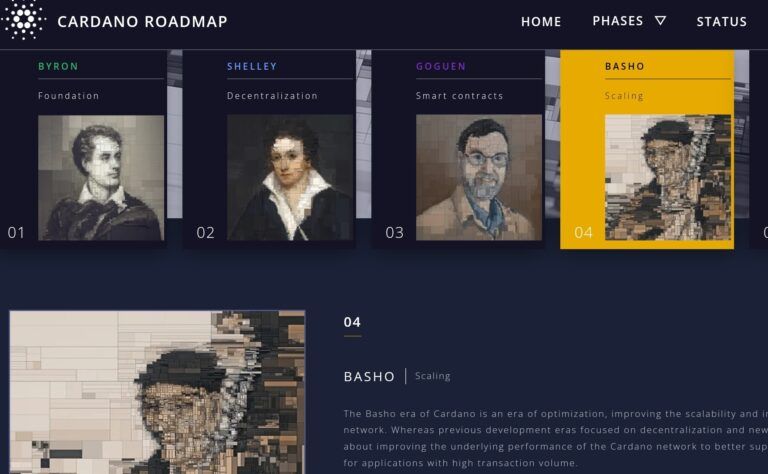A highly popular pseudonymous Cardano ($ADA) whale says that in 2022 he expects the L1 blockchain’s transaction throughput to increase to 500-1000.
According to a report published by CoinDesk earlier today, “ADA Whale” (“cardano_whale” on Twitter) told them via a Twitter chat:
“Keep eyes on the various scaling initiatives coming to Cardano the next months… Cardano Chain is currently running at pretty much full capacity, block size likely increases by the end of the month, next month will see the Babbage hard fork, which helps things further… Transactions per second should scale to 500-1000 this year in various ways.“
Last Friday (January 14), Tim Harrison, Marketing and Communications Director at Input Output Global (IOG), the blockchain technology firm developing the Cardano protocol, talked about his firm’s focus on performance optimization and scaling for the popular L1 blockchain.
In an IOG blog post published on January 14, Harrison started by by saying that as Cardano enters the Basho era, IOG is “investing further energy into optimization and scaling.
He went on to say that “parameter adjustments, improvements, enhancements and other innovations will all play their part in steadily increasing Cardano’s capacity & throughput during 2022.”
First, Harrison looked at various on-chain optimization and scaling solutions:
- Block size increase
- Pipelining
- Input Endorsers
- Memory /CPU parameters for Plutus
- Plutus script enhancements
- Node enhancements
- On-disk storage
Second, IOG’s Marketing and Communications Director highlighted several potential off-chain optimization and scaling solutions:
- Sidechains
- Hydra
- Off-chain computing
- Mithril
In a recent interview (with Crypto Capital Venture Founder Dan Gambardello) Cardano founder Charles Hoskinson talked about his vision for Cardano in 2022.
According to a report by The Daily Hodl, here are a few highlights from that interview:
- “I think everything will get done that I outlined – the sidechains, the pipelining, the import endorsers, the library optimization, Hydra and Mithril... Now there are degrees and flavors like there’ll be more Hydra stuff to do, but at least you’ll be able to use Hydra for something like microtransactions... Mithril will be probably completely finished because it’s a finite scope of work, and we had to bring on some sophisticated contractors for it.“
- “You can always optimize pipelining and do more in those heartbeats and the same for input endorsers – there are always ways to optimize that... But some version of it will ship, and… I think we’ll be in an exceedingly strong position to match what we see with Solana and these other platforms, but have the added benefit of being actually decentralized and having real theory and strong foundations behind it.“
So, what are Hydra and Mithril?
Well, in a blog post published on 17 September 2021, Sebastien Nagel, Software Engineering Lead at IOG (formerly known aas “IOHK), the blockchain technology firm responsible for Cardano’s R&D, said that one of the exciting developments enabled by the Alonzo upgrade was “Hydra, a key layer 2 solution to further improve Cardano’s scalability layering a new protocol on top of the existing layer 1 blockchain.”
According to Nagel, here are the concerns that Hydra aims to address:
“In a blockchain network, a consensus algorithm creates a secure and trustless environment by ensuring agreement on a transaction history. Cardano uses Ouroboros, an efficient proof-of-stake consensus algorithm, for this very purpose. But Cardano also, just like any permissionless blockchain, faces challenges when trying to scale to achieve the throughput required to support applications in the real world, including payment, identification, game, or mobile services…
“Cardano transactions incur fees. The people who run the network (in the case of Cardano, the stake pool operator community) need to be rewarded appropriately for the part they play, so fees need to be set at a sustainable level. Users want to pay fees they deem acceptable. In addition, the blockchain needs to be protected against Denial-of-Service (DoS) attacks, for example.
“Fees can therefore not be set so low as to open up undue risk – DoS events must be made prohibitively costly to a potential attacker. Storage is also a concern, as an ever-growing transaction history can lead to storage problems. Effectively, the most successful blockchains risk becoming ‘victims’ of that very success.“
Then, on 30 October 2021, during a “Surprise AMA” session (from Ethopia), Hoskinson said that development work on Hydra is “going very well”. More specifically, he said:
“We are going to keep adding resources to Hydra, and we’ve been trying to identify some teams so we can parallelize the workstream because it’s such a high commercial priority. And it’s going to be very important that we’ll be able to offload a large number of the transaction traffic that’s going to come from all of the apps that are coming.“
As for Mithril, as Olga Hryniuk explained in a blog post published on 29 October 2021, at the Cardano Summit 2021, “IOHK researchers Pyrros Chaidos and Roman Oliynykov presented the design and goals of Mithril – new research and engineering effort carried out by IOHK.” Mithril “will provide a stake-based threshold signature scheme that can be implemented as the protocol to solve chain synchronization, state bootstrapping, and trust issues in blockchain applications.”
She went on to say that Mithril is “the name used for a fictional metal in Middle-Earth – a malleable material, very light in weight but strong as ‘triple steel’, which does not tarnish or dim.” Therefore, “the name symbolizes strength in terms of security and a lightweight approach with regard to the developed protocol.”
Disclaimer
The views and opinions expressed by the author, or any people mentioned in this article, are for informational purposes only, and they do not constitute financial, investment, or other advice. Investing in or trading cryptoassets comes with a risk of financial loss.









